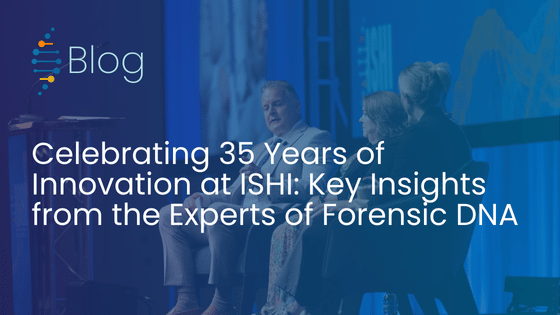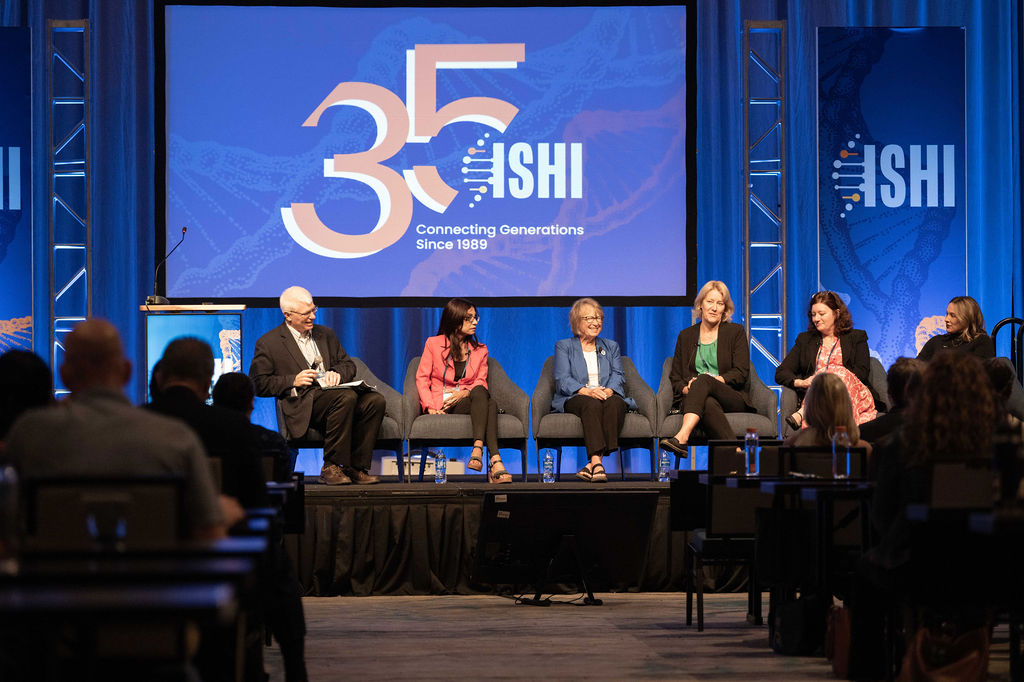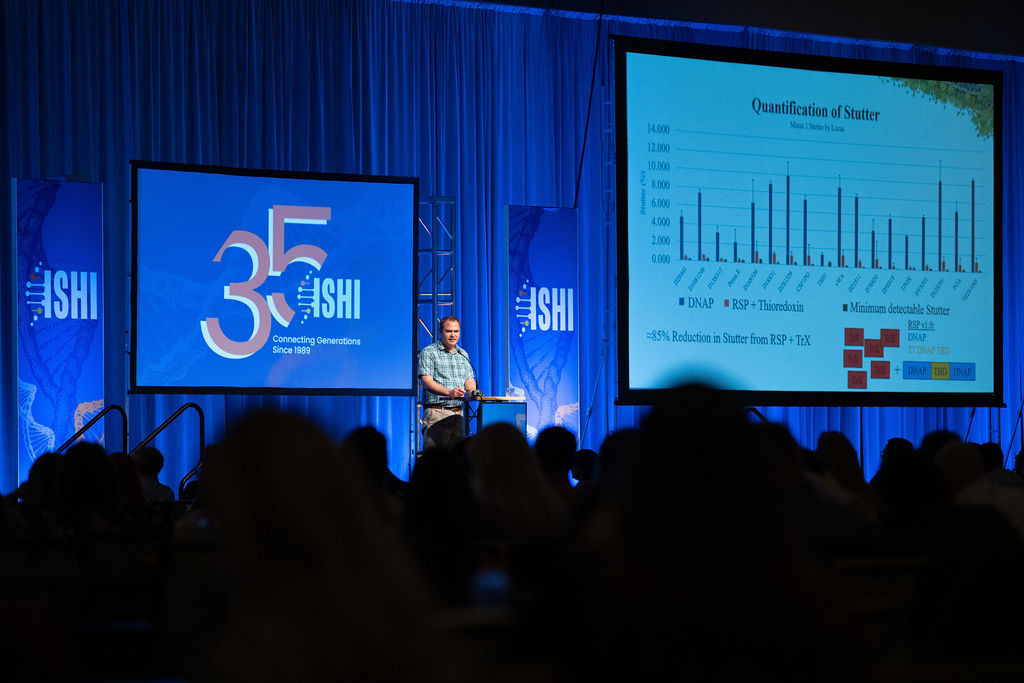Today’s guest blog is written by Kari Siegenthaler, Promega.
“As we celebrate the 35th anniversary of ISHI, it’s clear that forensic DNA technology has evolved from a novel concept to an indispensable tool in the pursuit of justice,” Bill Linton of Promega said during his opening remarks. This year’s International Symposium on Human Identification (ISHI) marked a milestone, reflecting on decades of advancements while showcasing the cutting-edge developments currently shaping the future of forensic science.

35 Years of Progress
The 35th anniversary of ISHI was not just a celebration of past accomplishments, but a forward-looking exploration of the most pressing and transformative trends in DNA forensics.
Over five days, forensic scientists, law enforcement professionals, legal experts, and aspiring students came together to share knowledge. Keynote sessions were the heart of the event, each offering a unique perspective on how forensic science continues to evolve in response to both historical cases (being solved decades later!) and emerging challenges.
The event was filled with specialized workshops and discussions that explored themes like investigative genetic genealogy (IGG), Rapid DNA, and the impact of artificial intelligence on forensic workflows, all while acknowledging the foundational role ISHI has played in bringing the community together over the past 35 years.
Keynote Highlights: A Glimpse into the Future of Forensics
Dr. Anna Barbaro: Inspiring a New Generation of Forensic Scientists
Kicking off the keynotes, Dr. Anna Barbaro, of the Worldwide Association of Women Forensic Experts, delivered a powerful message on the changing face of forensic science. She connected the rising wave of interest in true crime with a surge in women entering the field of forensic DNA. Her session set the tone for the event, highlighting the human impact behind scientific progress.
Turi King: Unraveling DNA Family Secrets
In one of the most captivating presentations, Dr. Turi King shared stories from the popular TV show DNA Family Secrets, showcasing the real-world emotional and scientific complexities of using DNA to uncover long-buried family mysteries. King’s presentation took attendees through the journey of applying advanced DNA analysis to solve deeply personal cases of lost identity and ancestry. Emotions were palpable in the room as she shared how forensic technology is not only about solving crimes but also about restoring identities that history has erased.
Patty Wetterling and Joy Baker: The Jacob Wetterling Story
Patty Wetterling and Joy Baker’s deeply emotional session recounted the decades-long search for answers in the abduction of Patty’s son, Jacob. The case, which remained unsolved for 27 years, was ultimately resolved using advancements in DNA technology. Their presentation served as a reminder of the enduring impact of forensic science on victims and families – bringing them justice and closure.
Ashley Flowers: From True Crime Podcasting to Pioneering Justice
Ashley Flowers, the founder of audiochuck and host of the Crime Junkie Podcast, discussed her journey from content creator to advocate. She spoke about the role true crime media has played in generating public interest in unsolved cases and how that, in turn, has driven advancements in forensic DNA technology through the raising of funds to reopen cold cases.

Emerging Trends from Key Sessions
Rapid DNA and Disaster Victim Identification
Rapid DNA technology was a focal point throughout the conference, particularly in its application for disaster victim identification and law enforcement. In his presentation, Douglas Hares of the FBI spoke about the progress in accrediting Rapid DNA and its implications for forensic timelines. With increased use in mass casualty events and crime scenes, Rapid DNA is set to dramatically speed up the process of victim identification, providing quick closure to families.
AI and Forensic DNA Analysis
Dr. Meng-Han Lin presented on how AI is transforming DNA analysis in forensic labs, making the process more efficient and accurate. As technology evolves, AI tools are expected to handle more complex DNA data sets, paving the way for faster and more reliable forensic results.
Investigative Genetic Genealogy (IGG)
The advancements in IGG were prominently featured, with Ray Wickenheiser and Claire Glynn providing a roadmap for setting up forensic IGG programs. Their presentation focused on the balance between investigative power and privacy, a key concern as this technology becomes more widely adopted in both cold case investigations and exoneration efforts.
Unveiling New Technology: David Mokry’s Presentation on Reducing DNA Analysis Stutter
David Mokry from Promega introduced an innovative enzyme designed to significantly reduce stutter artifacts in forensic DNA analysis—a longstanding challenge in STR profiling. Mokry explained that this breakthrough stemmed from Promega’s work in protein engineering, focusing on overcoming the noise in DNA data caused by amplification artifacts. He noted, “Our reduced stutter problem is essentially eliminated with this new enzyme, reduced by 10-fold” allowing for cleaner, more accurate data from mixed DNA samples.
This novel enzyme is set to be featured in Promega’s upcoming 8-color chemistry kits, kicking off with 27GY in 2025, and is expected to be a gamechanger for forensic workflows. Traditionally, stutter has caused challenges in distinguishing between alleles, complicating case analysis, especially in samples containing multiple contributors. Mokry emphasized the importance of this development in improving reliability, saying, “It took a little bit of innovation as we went through 1,000+ enzyme designs to create something truly revolutionary.“
This advancement represents a significant leap forward in forensic DNA technology, allowing for faster and more precise case resolutions. According to the Promega press release, this reduced stutter polymerase will reduce the need for repeated analysis and improve clarity in criminal investigations.

Networking and Community: Reflecting on 35 Years of Collaboration
Beyond the keynote sessions and exciting technological developments, ISHI’s 35th anniversary also celebrated the close-knit forensic science community. Attendees from around the globe gathered not just to learn, but to network and celebrate together. The Welcome Reception, Young Scientists’ Showcase, and various networking events encouraged new relationships and collaborations that will undoubtedly shape the future of forensic science. This global network of experts advancing the field hand-in-hand has been a hallmark of ISHI for 35 years and keeps participants returning year after year.
Looking Ahead: The Future of Forensic Science
As ISHI looks to the future, it’s clear that years to come will be shaped by rapid technological advancements and an ongoing commitment to justice. From AI-enhanced DNA analysis to the ethical considerations of genetic genealogy, this group continues to push the boundaries of what is possible. The discussions at ISHI 35 reinforced the idea that forensic DNA technology is not static – it is evolving.
Closing with a sense of optimism for what lies ahead and a recognition of how far the field has come, ISHI 35 was a great success. Forensic DNA is not just a tool for solving crimes—it’s a means of bringing hope and resolution to countless families and communities worldwide.

